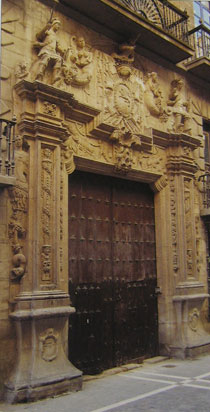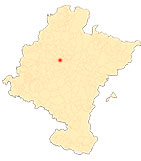18th Century Pamplona Palaces
Main house of the estate of the Marquis of San Miguel de Aguayo
It is linked to the lineage of the Echeverz family, originally from Berrioplano. Its promoter was Agustín de Echeverz, the first-born son, born in 1646. In 1662 he travelled to New Spain, where he became a military man and married a wealthy noblewoman. Nobility and Economics were fused in the same lineage. He returned to Spain where he completed an unparalleled rise. In 1682 he took the habit of Santiago and the marquisate of San Miguel de Aguayo, and later became constable of the kingdom of Navarre at degree scroll . After returning to the Indies as governor of the New Kingdom of León, he returned to Pamplona, focusing his efforts on building a house that would be in harmony with his status and that of his family. In 1698 he contracted the work with the stonemason Pedro de Arriarán, and in 1709, his daughter's third husband contracted the façade, leaving two years later for the Indies on a voyage of no return. At the beginning of the 19th century, it was acquired by José de Ezpeleta y Galdeano, who had been viceroy of Nueva Granada and who would later become viceroy of Navarre. The façade stands out above all, with allegorical contents alluding to the virtues and military substratum of the family, without forgetting the need for an intellectual training , materialised in the reproduction on the lintel of the emblem "non solum armis" (not only with arms) from the repertoire of Diego Saavedra Fajardo.
ANDUEZA UNANUA, Pilar, La arquitectura señorial de Pamplona en el siglo XVIII. Familias, urbanismo y ciudad, Pamplona, Government of Navarre, 2004.












